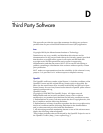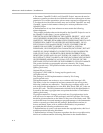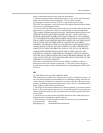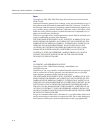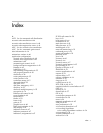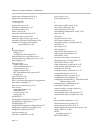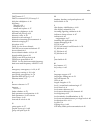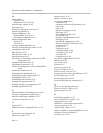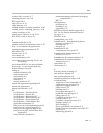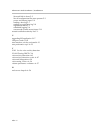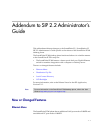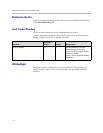
Index
Index – 3
DHCP menu 3–7
DHCP or manual TCP/IP setup 3–2
dial plan <dialplan> A–16
digit map
default A–18
examples A–17
match and replace A–17
digit map <digitmap> A–94
directed call pick-up 4–19
directory <dir> A–58
distinctive call waiting 4–7
distinctive incoming call treatment 4–6
distinctive ringing 4–7
diversion A–90
DND. See also do not disturb
DNS SIP server name resolution 4–35
do not disturb 4–8
do not disturb <dnd> A–89, A–92
downloadable fonts 4–28
DTMF event RTP payload 4–44
DTMF tone generation 4–43
DTMF. See also dual tone multi-frequency
dual tone multi-frequency <DMTF> A–25
E
emergency <emergency> A–19, A–95
emergency routing A–19, A–96
encryption <encryption> A–74
Ethernet IEEE 802.1p/Q A–47
Ethernet menu 3–11
F
feature <feature> A–77
features
list of 1–5
finder <finder> A–78
flash parameter configuration
A–99
flash parameter. See also device
fonts <font> A–60
forward all <fwd> A–90
G
gains <gain> A–37
graphic icons <gi> A–68
group call pick-up 4–20
H
handset, headset, and speakerphone 4–9
hold <hold> A–58
I
idle display <idleDisplay> A–80
idle display animation 4–14
incoming signaling validation 4–49
indicator classes <class> A–67
indicators A–65
assignments A–67
installing SIP application 3–14
instant messaging 4–26
IP TOS A–48
IP TOS call control <callControl> A–50
IP_400 font A–62
IP_500 font A–63
IP_600 font A–63
J
jitter buffer 4–42
K
key features 1–5
keys <key> A–63
L
language support 4–27
languages, adding new A–21
last call return 4–20
LEDs A–68
length <length> A–74
local / centralized conferencing 4–17
local <local> A–6
local contact directory 4–9
local contact directory file format 4–10
local digit map 4–12
local reminder <localReminder> A–58
local user and administrator privilege levels 4–48
localization <lcl> A–19
log files 5–4
logging <log> A–69
low-delay audio packet transmission 4–42





